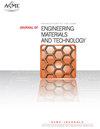Mechanical Properties and Fracture Resistance of 3D Printed PLA
IF 1.9
4区 材料科学
Q3 ENGINEERING, MECHANICAL
Journal of Engineering Materials and Technology-transactions of The Asme
Pub Date : 2023-10-03
DOI:10.1115/1.4063614
引用次数: 0
Abstract
Abstract 3D printing is a layer by layer deposition process, which results in highly anisotropic structures, and contain interfaces. Complex shapes manufactured by 3D printing carry defects. Complete elimination of these defects and interfaces is not possible, and these defects degrade the mechanical properties. In the present study, mechanical properties of printed dog bone samples are quantified as a function of building parameters, in particular, filling patterns, raster angle, and orientation of build direction with respect to that of loading, in polylactic acid (PLA). The tensile strength of 3D printed PLA is the same for hexagonal and linear pattern filling when build direction is along thickness and width, and failure was initiated at the defects in the structure, while better overall toughness is offered by hexagonal pattern filling. Build direction along specimen gauge length gives very low tensile strength and toughness, and failure happens between the printing layers. To minimize the defects especially near the grip section, cuboid sample were first deposited, and micro-machined by laser into dog bone shape to perform tension test. Tensile strength and elastic modulus of micro-machined samples are surprisingly lower, while failure strain is highest among line filling printed samples. Damage resistance was quantified in terms of work of fracture, and hexagonal filling provided better damage resistance than line filling patterns for conditions of 0º raster angle with respect to the crack whereas line filling with 45º and 90º raster angle tolerated damage better than hexagonal filling.3D打印PLA的力学性能和抗断裂性能
3D打印是一个逐层沉积的过程,其结果是高度各向异性的结构,并且包含界面。3D打印制造的复杂形状存在缺陷。完全消除这些缺陷和界面是不可能的,这些缺陷会降低机械性能。在本研究中,打印狗骨样品的力学性能被量化为建筑参数的函数,特别是填充模式、光栅角度和构建方向相对于加载方向的方向,在聚乳酸(PLA)中。当构建方向为厚度和宽度方向时,六边形和线性图案填充的3D打印PLA的抗拉强度相同,并且从结构缺陷处开始破坏,而六边形图案填充具有更好的整体韧性。沿着试样测量长度的构建方向,拉伸强度和韧性非常低,并且在打印层之间发生故障。为了最大限度地减少缺陷,特别是在握把部分附近,首先沉积长方体样品,然后用激光微加工成狗骨形状进行拉伸试验。微加工样品的抗拉强度和弹性模量较低,而线填充印刷样品的破坏应变最高。用断裂功来量化抗损伤能力,在0º栅格角条件下,六角形填充比线填充的抗损伤能力更好,而45º和90º栅格角的线填充比六角形填充的抗损伤能力更好。
本文章由计算机程序翻译,如有差异,请以英文原文为准。
求助全文
约1分钟内获得全文
求助全文
来源期刊
CiteScore
3.00
自引率
0.00%
发文量
30
审稿时长
4.5 months
期刊介绍:
Multiscale characterization, modeling, and experiments; High-temperature creep, fatigue, and fracture; Elastic-plastic behavior; Environmental effects on material response, constitutive relations, materials processing, and microstructure mechanical property relationships

 求助内容:
求助内容: 应助结果提醒方式:
应助结果提醒方式:


